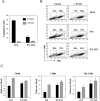A simian virus 5 (SV5) P/V mutant is less cytopathic than wild-type SV5 in human dendritic cells and is a more effective activator of dendritic cell maturation and function
- PMID: 16537609
- PMCID: PMC1440371
- DOI: 10.1128/JVI.80.7.3416-3427.2006
A simian virus 5 (SV5) P/V mutant is less cytopathic than wild-type SV5 in human dendritic cells and is a more effective activator of dendritic cell maturation and function
Abstract
Human epithelial cells infected with the parainfluenza virus simian virus 5 (SV5) show minimal activation of host cell interferon (IFN), cytokine, and cell death pathways. In contrast, a recombinant SV5 P/V gene mutant (rSV5-P/V-CPI-) overexpresses viral gene products and is a potent inducer of IFN, proinflammatory cytokines, and apoptosis in these cells. In this study, we have compared the outcomes of wild-type (WT) SV5 and rSV5-P/V-CPI- infections of primary human dendritic cells (DC), important antigen-presenting cells for initiating adaptive immune responses. We have tested the hypothesis that a P/V mutant which activates host antiviral responses will be a more potent inducer of DC maturation and function than WT rSV5, which suppresses host cell responses. Infection of peripheral blood mononuclear cell-derived immature DC with WT rSV5 resulted in high levels of viral protein and progeny virus but very little increase in cell surface costimulatory molecules or secretion of IFN and proinflammatory cytokines. In contrast, immature DC infected with the rSV5-P/V-CPI- mutant produced only low levels of viral protein and progeny virus, but these infected cells were induced to secrete IFN-alpha and other cytokines and showed elevated levels of maturation markers. Unexpectedly, DC infected with WT rSV5 showed extensive cytopathic effects and increased levels of active caspase-3, while infection of DC with the P/V mutant was largely noncytopathic. In mixed-culture assays, WT rSV5-infected DC were impaired in the ability to stimulate proliferation of autologous CD4+ T cells, whereas DC infected with the P/V mutant were very effective at activating T-cell proliferation. The addition of a pancaspase inhibitor to DC infected with WT rSV5 reduced cytopathic effects and resulted in higher surface expression levels of maturation markers. Our finding that the SV5 P/V mutant has both a reduced cytopathic effect in human DC compared to WT SV5 and an enhanced ability to induce DC function has implications for the rational design of novel recombinant paramyxovirus vectors based on engineered mutations in the viral P/V gene.
Figures








Similar articles
-
Naturally occurring substitutions in the P/V gene convert the noncytopathic paramyxovirus simian virus 5 into a virus that induces alpha/beta interferon synthesis and cell death.J Virol. 2002 Oct;76(20):10109-21. doi: 10.1128/jvi.76.20.10109-10121.2002. J Virol. 2002. PMID: 12239285 Free PMC article.
-
Apoptosis induction and interferon signaling but not IFN-beta promoter induction by an SV5 P/V mutant are rescued by coinfection with wild-type SV5.Virology. 2003 Nov 10;316(1):41-54. doi: 10.1016/s0042-6822(03)00584-1. Virology. 2003. PMID: 14599789
-
Growth sensitivity of a recombinant simian virus 5 P/V mutant to type I interferon differs between tumor cell lines and normal primary cells.Virology. 2005 Apr 25;335(1):131-44. doi: 10.1016/j.virol.2005.02.004. Virology. 2005. PMID: 15823612
-
Paramyxovirus activation and inhibition of innate immune responses.J Mol Biol. 2013 Dec 13;425(24):4872-92. doi: 10.1016/j.jmb.2013.09.015. Epub 2013 Sep 20. J Mol Biol. 2013. PMID: 24056173 Free PMC article. Review.
-
Simian hemorrhagic fever virus: Recent advances.Virus Res. 2015 Apr 16;202:112-9. doi: 10.1016/j.virusres.2014.11.024. Epub 2014 Nov 29. Virus Res. 2015. PMID: 25455336 Free PMC article. Review.
Cited by
-
Mumps virus inhibits migration of primary human macrophages toward a chemokine gradient through a TNF-alpha dependent mechanism.Virology. 2012 Nov 10;433(1):245-52. doi: 10.1016/j.virol.2012.08.017. Epub 2012 Aug 28. Virology. 2012. PMID: 22935226 Free PMC article.
-
Replication-independent activation of human plasmacytoid dendritic cells by the paramyxovirus SV5 Requires TLR7 and autophagy pathways.Virology. 2010 Sep 30;405(2):383-9. doi: 10.1016/j.virol.2010.06.023. Epub 2010 Jul 6. Virology. 2010. PMID: 20605567 Free PMC article.
-
Nonstructural proteins 1 and 2 of respiratory syncytial virus suppress maturation of human dendritic cells.J Virol. 2008 Sep;82(17):8780-96. doi: 10.1128/JVI.00630-08. Epub 2008 Jun 18. J Virol. 2008. PMID: 18562519 Free PMC article.
-
TLR-4 and -6 agonists reverse apoptosis and promote maturation of simian virus 5-infected human dendritic cells through NFkB-dependent pathways.Virology. 2007 Aug 15;365(1):144-56. doi: 10.1016/j.virol.2007.02.035. Epub 2007 Apr 24. Virology. 2007. PMID: 17459446 Free PMC article.
-
Recombinant parainfluenza virus 5 (PIV5) expressing the influenza A virus hemagglutinin provides immunity in mice to influenza A virus challenge.Virology. 2007 May 25;362(1):139-50. doi: 10.1016/j.virol.2006.12.005. Epub 2007 Jan 23. Virology. 2007. PMID: 17254623 Free PMC article.
References
-
- Andrejeva, J., D. F. Young, S. Goodbourn, and R. E. Randall. 2002. Degradation of STAT1 and STAT2 by the V proteins of SV5 and human parainfluenza virus type 2, respectively: consequences for virus replication in the presence of alpha/beta and gamma interferons. J. Virol. 76:2159-2167. - PMC - PubMed
-
- Baize, S., J. Kaplon, C. Faure, D. Pannetier, M. C. Georges-Courbot, and V. Deubel. 2004. Lassa virus infection of human dendritic cells and macrophages is productive but fails to activate cells. J. Immunol. 172:2861-2869. - PubMed
-
- Banchereau, J., F. Briere, C. Caux, J. Davoust, S. Lebecque, Y. J. Liu, B. Pulendran, and K. Palucka. 2000. Immunobiology of dendritic cells. Annu. Rev. Immunol. 18:767-811. - PubMed
Publication types
MeSH terms
Substances
Grants and funding
LinkOut - more resources
Full Text Sources
Other Literature Sources
Research Materials

